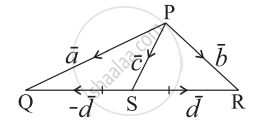Advertisements
Advertisements
प्रश्न
In Figure, identify the following vector.

Collinear but not equal
उत्तर
- Vectors `veca` and `vecc` are collinear but not equal.
- This is because their directions are not the same but parallel.
APPEARS IN
संबंधित प्रश्न
if `veca = 2hati - hatj - 2hatk " and " vecb = 7hati + 2hatj - 3hatk`, , then express `vecb` in the form of `vecb = vec(b_1) + vec(b_2)`, where `vec(b_1)` is parallel to `veca` and `vec(b_2)` is perpendicular to `veca`
If \[\vec{a}\] and \[\vec{b}\] represent two adjacent sides of a parallelogram, then write vectors representing its diagonals.
If \[\vec{a}\], \[\vec{b}\], \[\vec{c}\] are position vectors of the vertices A, B and C respectively, of a triangle ABC, write the value of \[\overrightarrow{AB} + \overrightarrow{BC} + \overrightarrow{CA} .\]
If D, E, F are the mid-points of the sides BC, CA and AB respectively of a triangle ABC, write the value of \[\overrightarrow{AD} + \overrightarrow{BE} + \overrightarrow{CF} .\]
Find a unit vector in the direction of \[\overrightarrow{a} = 2 \hat{i} - 3 \hat{j} + 6 \hat{k}\].
If \[\vec{a} , \vec{b}\] are the vectors forming consecutive sides of a regular hexagon ABCDEF, then the vector representing side CD is
If G is the intersection of diagonals of a parallelogram ABCD and O is any point, then \[O \vec{A} + O \vec{B} + O \vec{C} + O \vec{D} =\]
If ABCDEF is a regular hexagon, then \[\overrightarrow{AD} + \overrightarrow{EB} + \overrightarrow{FC}\] equals
If three points A, B and C have position vectors \[\hat{i} + x \hat{j} + 3 \hat{k} , 3 \hat{i} + 4 \hat{j} + 7 \hat{k}\text{ and }y \hat{i} - 2 \hat{j} - 5 \hat{k}\] respectively are collinear, then (x, y) =
In the given figure express `bar"c"` and `bar"d"` in terms of `bar"a"` and `bar"b"`.

Find the coordinates of the point which is located in the YZ-plane, one unit to the right of the XZ- plane, and six units above the XY-plane.
Select the correct option from the given alternatives:
Let α, β, γ be distinct real numbers. The points with position vectors `alphahat"i" + betahat"j" + gammahat"k", betahat"i" + gammahat"j" + alphahat"k", gammahat"i" + alphahat"j" + betahat"k"`
Select the correct option from the given alternatives:
The value of `hat"i".(hat"j" xx hat"k") + hat"j".(hat"i" xx hat"k") + hat"k".(hat"i" xx hat"j")` is
If `|bar"a"| = |bar"b"| = 1, bar"a".bar"b" = 0, bar"a" + bar"b" + bar"c" = bar"0", "find" |bar"c"|`.
Find the lengths of the sides of the triangle and also determine the type of a triangle:
A(2, -1, 0), B(4, 1, 1), C(4, -5, 4)
Find the unit vectors that are parallel to the tangent line to the parabola y = x2 at the point (2, 4).
If `bar"a", bar"b", bar"c"` are unit vectors such that `bar"a" + bar"b" + bar"c" = bar0,` then find the value of `bar"a".bar"b" + bar"b".bar"c" + bar"c".bar"a".`
Express the vector `bar"a" = 5hat"i" - 2hat"j" + 5hat"k"` as a sum of two vectors such that one is parallel to the vector `bar"b" = 3hat"i" + hat"k"` and other is perpendicular to `bar"b"`.
Show that no line in space can make angles `pi/6` and `pi/4` with X-axis and Y-axis.
Find the angle between the lines whose direction cosines are given by the equations 6mn - 2nl + 5lm = 0, 3l + m + 5n = 0.
State whether the expression is meaningful. If not, explain why? If so, state whether it is a vector or a scalar:
`(bar"a" xx bar"b").(bar"c"xxbar"d")`
State whether the expression is meaningful. If not, explain why? If so, state whether it is a vector or a scalar:
`|bar"a"|. (bar"b" + bar"c")`
The points A(- a, -b), B (0, 0), C(a, b) and D(a2 , ab) are ______.
For 0 < θ < π, if A = `[(costheta, -sintheta), (sintheta, costheta)]`, then ______
If the points (–1, –1, 2), (2, m, 5) and (3,11, 6) are collinear, find the value of m.
Find the unit vector in the direction of the sum of the vectors `vec"a" = 2hat"i" - hat"j" + hat"k"` and `vec"b" = 2hat"j" + hat"k"`.
Classify the following as scalar and vector quantity.
Distance
Classify the following as scalar and vector quantity.
Force
If `veca ≠ vec(0), veca.vecb = veca.vecc, veca xx vecb = veca xx vecc`, then show that `vecb = vecc`.
Which of the following measures as vector?
Find `|vecx|` if `(vecx - veca).(vecx + veca)` = 12, where `veca` is a unit vector.
Unit vector along `vec(PQ)`, where coordinates of P and Q respectively are (2, 1, – 1) and (4, 4, – 7), is ______.
Check whether the vectors `2 hati + 2 hatj + 3 hatk, -3 hati + 3 hatj + 2 hatk "and" 3 hati + 4 hatk` from a triangle or not.
Find the value of λ for which the points (6, – 1, 2), (8, – 7, λ) and (5, 2, 4) are collinear.
In the triangle PQR, `bb(bar(PQ) = 2 bara)` and `bb(bar(QR) = 2 barb)`. The mid-point of PR is M. Find the following vectors in terms of `bb(bara and barb)`.
- `bar(PR)`
- `bar(PM)`
- `bar(QM)`
In the triangle PQR, `bar(PQ)=2bara` and `bar(QR)=2barb`. The mid-point of PR is M. Find following vectors in terms of `bara and barb`.
(i) `bar(PR)` (ii) `bar(PM)` (iii) `bar(QM)`
Check whether the vectors `2hati + 2hatj + 3hatk, -3hati + 3hatj + 2hatk and 3hati + 4hatk` form a triangle or not.
Check whether the vectors `2hati + 2hatj +3hatk, - 3hati + 3hatj + 2hatk and 3hati + 4hatk` form a triangle or not.
Check whether the vectors `2hati + 2hatj + 3hatk, -3hati + 3hatj + 2hatk and 3hati + 4hatk` form a triangle or not.
